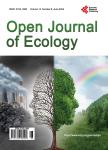Effects of Land Use on the Riparian Vegetation along the Njoro and Kamweti Rivers, Kenya
Effects of Land Use on the Riparian Vegetation along the Njoro and Kamweti Rivers, Kenya作者机构:Department of Environmental Science Egerton University Egerton Kenya Department of Biological Sciences Egerton University Egerton Kenya Dryland Research Training and Ecotourism Centre Chemeron Egerton University Egerton Kenya
出 版 物:《Open Journal of Ecology》 (生态学期刊(英文))
年 卷 期:2021年第11卷第11期
页 面:807-827页
学科分类:0907[农学-林学] 08[工学] 0829[工学-林业工程] 09[农学]
主 题:Land Use Riparian Vegetation Composition Distribution Diversity
摘 要:Riparian zones are valuable ecosystems. They act as the ecological engineers that improve river health by delivering a range of ecosystem functions. They play a significant role in river health and provide various ecosystem goods and services for human well-being. Currently, riparian areas are under threat due to intensive human activities such as agriculture and urbanization, which alter riparian ecosystem structure and composition. The main objective of this study was to determine the effect of adjacent land use on the structure and diversity of the riparian vegetation in the Njoro and Kamweti Rivers. Along each river, three sampling sites were selected within the major land use categories which were;forest, agricultural and built-up areas. At each site, three 70 m long transects were established perpendicular to the river. The three plots were systematically established, separated by a 5 m distance along each transect. Forest canopy cover was estimated in percentage. Njoro River riparian vegetation recorded a total of 145 plant species from 40 families where trees and shrubs were dominant in the forest area, and herbs dominated the agricultural and built-up areas. In Kamweti River riparian area, a total of 110 species from 45 families were encountered, in which trees dominated the forest area. A similar trend to the Njoro River was observed, in which herbs were dominant in the agricultural and built-up areas. In Njoro River, the Shannon diversity (H’) values ranged between 2.73 and 3.08 whereas Kamweti River riparian area values ranged from 2.59 to 3.40. At the level of P ≤ 0.05, T-Test revealed that there was no significant difference in plant abundance and diversity between the two rivers, with F = 0.53;P = 0.51 and F = 2.71;P = 0.17. Human-centered disturbances along the Njoro and Kamweti River riparian areas have affected the riparian vegetation as shown by the decrease in plant species diversities, and the change in vegetation composition and distribution ac



